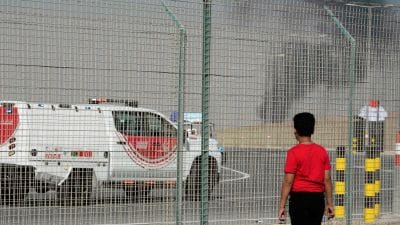On Haryana’s road to ‘near elimination of stubble burning’, some wins, some hiccups
But farmers and officials say it could take another couple of years to ensure easy availability of machines and incentives, focusing subsidies on implements in areas where burning is high, and awareness sessions, before the practice can be halted entirely.
 Till November 11, Kaithal has seen 229 instances of burning, IARI data shows, while Jind has seen 256 instances so far — lower than previous years. (see box).
Till November 11, Kaithal has seen 229 instances of burning, IARI data shows, while Jind has seen 256 instances so far — lower than previous years. (see box).
This year, two districts in Haryana, Kaithal and Jind, have seen a reduction in fires.
But farmers and officials say it could take another couple of years to ensure easy availability of machines and incentives, focusing subsidies on implements in areas where burning is high, and awareness sessions, before the practice can be halted entirely.
Unsold bales of straw prepped using what is becoming a popular, but expensive machine, a still hazy supply chain that leads to alternative uses of paddy straw, and some machines remaining out of reach for small farmers are among issues that are yet to be ironed out.
On the bright side, the fire count so far in Haryana is lower than it was last year.
From September 15 to November 11, Haryana has recorded 1703 instances of crop residue burning, according to data from IARI. This is lower than 2880 over the same period last year, 5063 in 2021, and 3447 in 2020. The highest single-day fire count that Haryana has seen so far is 127 on October 15, followed by 109 on November 5.
Till November 11, Kaithal has seen 229 instances of burning, IARI data shows. This is lower than 605 in 2022, 1090 in 2021, and 787 in 2020. Jind has recorded 256 instances so far, compared to 384 last year, 545 in 2021, and 284 in 2020.
Straw to bales
In Jind’s Raichandwala village, thousands of quintals of bales of straw, remnants of the recently harvested paddy crop, are stacked up on an acre of land — a fact Bijender Singh (50) is not happy about.
He is yet to find a buyer for what he estimates is nearly 15,500 quintals of straw that lie on that acre, collected using two balers — one his and another belonging to a resident of a neighbouring village — that have been running for a little over a month. The baler converts straw into portable bales that can be moved to units for use as fuel. “Nobody’s buying it, even at low prices. Maybe it will sell sometime in March or April when supply of straw is not this high,” Singh said. In the meantime, if it rains, bales out in the open will be destroyed.
Singh’s baler, the only one owned by any farmer in the village, is running as a form of “social service,” he said, albeit an expensive one – the baler and rake can cost Rs 18-20 lakh, on which a subsidy is provided, and the machine can consume up to 10 litres of diesel per acre of land it is operated on.
“Maintenance is expensive and it runs only for a season… We pay for lifting and transport of the bales, and land must be rented to stock them,” said Singh, who owns 2 acres of land himself.
He had better luck last year when a company in Jind, that is expected to generate electricity from the straw, bought 29,000 quintals of straw from Singh at a rate of Rs 172 per quintal. This year, with the company running its own balers, farmers with the machine in Jind have been finding it difficult to sell the straw they collect.
The baler is an ‘ex-situ’ stubble management method, now increasingly sought-after since paddy straw is taken away at no cost to the landowner. In Haryana, the landowner receives an incentive of Rs 1,000 per acre of land for choosing this alternative to burning stubble.
Compared to an ex-situ utilisation of 1.80 million tonnes of paddy straw in 2022, Haryana is aiming to use 1.95 million tonnes this year.
Not far from where Singh’s baler was running on a 2.5-acre of land, Ajmer (48) set fire to the stubble on a little over 2 acres of his land. “The crop was harvested 15 days ago. We had asked about the baler, it didn’t arrive. To use a super-seeder (another crop residue management machine that can plough the stubble back into the land, prepare the soil for the next crop, and sow seeds), it can cost Rs 2,500 for an acre which is too expensive,” he said.
Singh said with his being the only machine in the village, the waiting time to use the baler can be at least 5-7 days.
In neighbouring Dhatrath village, Jind Bio Energy, which has bought paddy straw from farmers in Jind over the past two years, has a total of 26 balers now running in Jind and Fatehabad. The straw is meant to feed a 15 MW power plant that is not running yet.
“We are using large, imported balers this time, instead of smaller ones that farmers have. The plant is not functional yet since we need a meter and the connection to the power grid is incomplete. This is the third year we are procuring the straw, but a lot of what we collected over the past two years was destroyed as we were not able to use it. Since bales made with smaller machines are not dense, they get destroyed in the rain,” said Ranjit Patel, plant head at the company.
In Kaithal, Karn Singh, sarpanch of Kotra village, has been more fortunate in dealing with the bales, having bought the machine only this year. “The baler is on a year-long bond with a company in Samana, Punjab. We have around 15,000-16,000 quintals so far from three villages, with an acre of paddy yielding 25 quintals of straw. Landowners are in a hurry for the bales to be taken away… they say they will set it on fire if it is not taken away quickly. This year, balers are being used a lot more. Crop residue burning has reduced, the government is stricter, and the mindset is also changing,” he said.
Satbir (48), who rents a 4-acre field to another farmer in Harsola village, said he considered purchasing a baler this year but decided against it. “Bales are not selling, and the baler is an expensive machine. You need the tractor, trolleys, labour to pick up bales. I had applied for it (for a subsidy under the crop residue management scheme) but then decided not to buy it. A relative tried using the baler last year and was able to sell only some of the straw, the rest was destroyed in the rains. Stubble here is either managed using a super-seeder or is set on fire,” he said.
Demand vs supply
JC Malik, Assistant Agriculture Engineer, Kaithal, said the district sees more ex-situ use of straw than any other in the state considering the presence of industrial units. “We had 350 balers running here this season, including 50 from Punjab, and baler use has been increasing over the past three years. There are three plants that are buying the straw. A paper mill, a solvent unit bought some straw, and a biomass power plant bought straw, but now their stock is complete. So, over the past week, baler owners have not been able to sell. Altogether we are aiming to use around 7 lakh metric tonnes this way, out of a straw generation of around 10.5 lakh metric tonnes,” Malik said.
Malik chalked up the reduction in instances of burning in Kaithal to better awareness. “But the problem now is consumption of the bales. Price is also falling now because of the supply. An ethanol plant is coming up at Panipat, and since it is a large plant, there is hope that consumption will eventually increase in other parts of the state. Another issue is that subsidies this year were focused on ‘red’ and ‘yellow’ zone villages, and farmers in the ‘green’ zone have not been able to get subsidies as easily,” he said.
Based on active fires last year, villages have been identified as ‘red,’ ‘yellow’ and ‘green’ zone villages, with ‘green’ zone ones having had the least burning last year.
On other measures, Malik said: “There are 2,200 super-seeders in Kaithal, though balers are more convenient for land owners. But the advantage of using methods like super-seeders is that the stubble has potassium and sulphur and when it is mixed in the soil, it doesn’t need fertiliser.”
In Jind, an official in the agriculture department pointed to the limited time between harvest and sowing of the winter crop, and the sale of bales as two factors that are yet to be addressed. “Machines are available, but there aren’t too many industrial units in Jind, so selling the bales is turning into a problem,” the official said.
Vijay Kumar, Assistant Agriculture Engineer, Jind, said, “We have enough of the other machines, but need more balers. Some farmers are stocking a supply of bales for the plant that is coming up at Panipat, in the hope it will buy from here as well. The biomass power plant in Kaithal had set a target of purchasing 30,000 metric tonnes from Jind. Last year, the biomass plant in Jind that is not functioning yet bought around 17,000 metric tonnes.”
Way ahead
The incentive to the individual farmer sets Haryana apart from Punjab. In Kaithal, a total of 14,758 farmers applied for the incentive last year, and 12,537 farmers have applied so far this season, Malik said.
Fines have also been imposed to deal with burning. Fines worth Rs 3.8 lakh have been imposed till the end of October on over 200 farmers, and 31 FIRs have been registered for burning in Kaithal, Malik said.
Fines of around Rs 2 lakh had been imposed till the end of October in Jind, and there are teams at the village, block, sub-division, and district level for monitoring, Kumar said. The district has 4.5 lakh acres under paddy cultivation, with paddy straw generation of 8.5 lakh tonnes.
“Give it another one-two years, it will get better. The problem is the small window between the harvest and sowing, and for a baler, there can be a waiting time of 4 to 5 days. We hope to manage 1.18 lakh metric tonnes through ex-situ measures. There are 70 balers so far, another 140 have been sanctioned,” Kumar added.
At the Agriculture Department’s office in Jind in the last week of October, officials held a session with farmers mostly from ‘red zone’ villages in Narwana. They were told about machines that can plough the stubble back into the soil, the harm burning can do to the soil, and how they can access machines. “Nobody is saying farmers are responsible for all the pollution. But it is a factor. It gets colder, and with that, the smoke from burning can impact the areas around us,” an official at the session told farmers.
According to the report submitted by the Commission for Air Quality Management (CAQM) before the National Green Tribunal in October, the target for Haryana this year was “near elimination of stubble burning.”
This year, Haryana has 80,071 machines to manage crop residue, higher than 72,777 machines available last year. In addition to using paddy straw as fuel in industrial units and in biomass power plants, it finds use in packaging and cardboard manufacturing, and as cattle fodder.
Haryana generates a total of 7.4 million tonnes of paddy straw, less than half the 19.5 million tonnes that Punjab generates. Of this, 1.95 million tonnes is likely to be managed through ex-situ measures, 3.19 million tonnes through in-situ measures, and 2.36 million tonnes to be used as cattle fodder, going by the CAQM report. According to the report, Haryana has fixed the rate of procurement of residue at Rs 2,500 per tonne.
A senior official in the Haryana Pollution Control Board said the availability of machines and incentives are methods that may be working in dealing with stubble burning, and efforts are underway to ensure supply of paddy straw pellets for co-firing in power plants.







